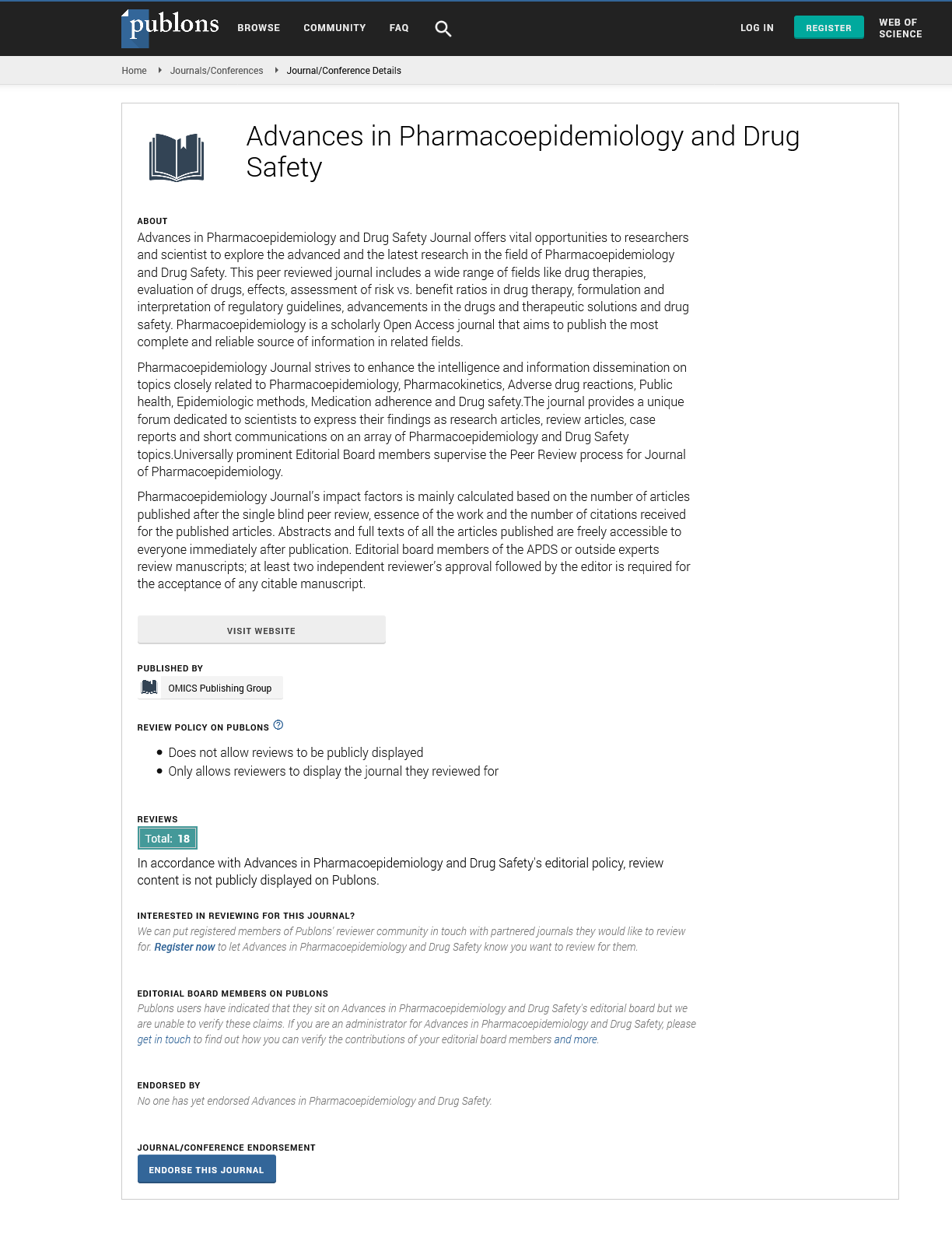Indexed In
- Open J Gate
- Genamics JournalSeek
- Academic Keys
- JournalTOCs
- RefSeek
- Hamdard University
- EBSCO A-Z
- SWB online catalog
- Publons
- Geneva Foundation for Medical Education and Research
- Euro Pub
- Google Scholar
Useful Links
Share This Page
Journal Flyer

Open Access Journals
- Agri and Aquaculture
- Biochemistry
- Bioinformatics & Systems Biology
- Business & Management
- Chemistry
- Clinical Sciences
- Engineering
- Food & Nutrition
- General Science
- Genetics & Molecular Biology
- Immunology & Microbiology
- Medical Sciences
- Neuroscience & Psychology
- Nursing & Health Care
- Pharmaceutical Sciences
Short Communication - (2023) Volume 12, Issue 2
Active Compounds of Pharmaceuticals and their Effects
Nisha Bansal*Received: 01-Mar-2023, Manuscript No. PDS-23-20430; Editor assigned: 03-Mar-2023, Pre QC No. PDS-23-20430 (PQ); Reviewed: 20-Mar-2023, QC No. PDS-23-20430; Revised: 27-Mar-2023, Manuscript No. PDS-23-20430 (R); Published: 04-Apr-2023, DOI: 10.35248/2167-1052.23.12.301
Description
In recent decades, pharmaceuticals believed to have saved millions of lives have become a new class of environmental pollutant. These compounds can have chronic and acute adverse effects on natural flora and fauna. The presence of pharmaceutical contaminants in groundwater, surface water (lakes, rivers, streams), seawater, sewage treatment plants (influents and effluents), soil, and sludge is well documented [1]. A variety of methods have been used for remediation from aqueous systems, including oxidation, photolysis, UV degradation, nanofiltration, reverse osmosis, and adsorption. Many processes are economically limited by toxic sludge formation, incomplete removal, high capital and operating costs, and the need for skilled operating and maintenance personnel. Adsorption technology is an easy-to-use, low-cost alternative in developing countries that lack advanced technology, skilled manpower, and available capital, and adsorption appears to be the most widely used drug removal method. Adsorption remediation methods can be easily integrated into WasteWater Treatment Plants (WWTPs). Here, we reviewed the literature (1990–2018) describing growing concerns about pharmaceutical contamination in the environment and remediation efforts focused on sorption [2].
Active pharmaceutical ingredients are one of the most important .The main source of pharmaceutical is sewage treatment plant effluents, as is continuously introduced into water systems. This include antibiotics, tranquilizers, diuretics, and psychotropics. There are several studies on bioremediation of PhAC by microalgae, including a study by Diaz on antibiotics. Cultures of C. reinhardtii and C. sorokiniana yielded high elimination rates and also grew vigorously on the antibiotic sulfapyridine. The feasibility of microalgae in the bioremediation of EP needs further investigation. Isolation of microalgae from pharmaceutical wastewater may help discover more PhAC-degrading microalgae in the future [3].
Pharmaceutically Active Compounds (PhACs) have detrimental effects on all types of organisms due to their toxicological effects and are widely found in various influents of sewage treatment plants, hospital effluents and surface waters. Concentrations of various drugs have been found at surprisingly high levels in different regions of the world, suggesting that concentrations of PhACs present in water may be potentially related to local socioeconomic conditions and climate [4]. Drinking water equivalence limits for each PhAC were calculated and compared with occurrence data from different continents. Advanced Oxidative Processes (AOPs) have shown greater efficiency in degrading these PhACs, as these compounds are intractable to conventional therapies. The AOP's performance was evaluated based on distance, time, and power to resolve different classes of PhACs. Ozone-based AOP has proven advantageous due to its short processing time, low cost and high efficiency. However, complete degradation cannot be achieved by these processes and various transformation products are formed that may be more toxic than the parent compound. The different transformation products formed from different PhACs during treatment are highlighted. The roles of different process parameters, water matrix, oxidizing radicals and degradation mechanisms were highlighted. The presence of the organic compounds nitrates and phosphates usually hinders the decomposition process, whereas chlorine and sulfates have shown positive effects. The role of individual oxidizing radicals, interfering ions and pH showed different effects on different groups of PhACs [5].
References
- Zjawiony JK. Biologically active compounds from Aphyllophorales (polypore) fungi. J Nat Prod. 2004;67(2):300-310.
[Crossref] [Google Scholar] [PubMed]
- Georgiou G, Lin SC, Sharma MM. Surface active compounds from microorganisms. Biotech.1992;10(1):60-65.
[Crossref] [Google Scholar] [PubMed]
- Bendz D, Paxéus NA, Ginn TR, Loge FJ. Occurrence and fate of pharmaceutically active compounds in the environment, a case study: Höje River in Sweden. J Hazard Mater. 2005;122(3):195-204.
[Crossref] [Google Scholar] [PubMed]
- Sheldon RA. Chirotechnology: industrial synthesis of optically active compounds.1993.
- Řezanka T, Sigler K. Biologically active compounds of semi-metals. Stud Nat Prod Chem. 2008;35:835-921.
[Crossref] [Google Scholar] [PubMed]
Citation: Bansal N (2023) Active Compounds of Pharmaceuticals and their Effects. Adv Pharmacoepidemiol Drug Saf. 12:301.
Copyright: © 2023 Bansal N. This is an open-access article distributed under the terms of the Creative Commons Attribution License, which permits unrestricted use, distribution, and reproduction in any medium, provided the original author and source are credited.

